Mainshock-Integrated Aftershock Vulnerability Assessment of Bridge Structures
Abstract
:Featured Application
Abstract
1. Introduction
2. Traditional Fragility Analysis and Adaption
2.1. Traditional Fragility Analysis
2.2. Simply Adapted Fragility Analysis for M-A Effects
3. Mainshock-Integrated Aftershock Fragility
3.1. Rationale and Formulation
3.2. Characteristics
- (1)
- In Equation (2) or (3) in reference [7], the probability of failure is expressed as a function of mainshock intensity; and the aftershock effects are revealed through a uniform scaling or selecting different mainshock/aftershock intensity-ratio parameters. The uncertainty of this ratio parameter is not modeled.
- (2)
- In the model developed in this study, the probability of failure is expressed as a function of aftershock intensity. The intensity of the mainshock is selected by an end-user following a design consideration (e.g., the design-level or the maximum-considered level ground motion), and its intra-record uncertainties are modeled through ground-motion selection.
4. Implementation and Case Study
4.1. Workflow
4.2. Bridge Modeling
4.3. Selection of M-A Sequences
5. Numerical Experimental Evaluation
5.1. Traditional Mainshock-Only and M-A Fragility Assessment
5.2. Mainshock-Integrated Fragility Function Model
6. Discussion and Conclusions
6.1. Discussion
6.2. Conclusions
Author Contributions
Funding
Conflicts of Interest
References
- Risk Management Solutions. Reconnaissance Report: The 2008 Wenchuan Earthquake: Risk Management Lessons and Implications; Risk Management Solutions: Newark, CA, USA, 2008. [Google Scholar]
- Wen, R.; Zhou, Z.; Li, X.; Yang, C.; Wang, Y.; Liu, Q.; Cui, J. The strong ground motion observation for the Wenchuan aftershock. Earthq. Sci. 2009, 22, 181–187. [Google Scholar] [CrossRef] [Green Version]
- U.S. Geological Survey. Available online: https://www.usgs.gov/news/magnitude-78-earthquake-nepal-aftershocks (accessed on 1 September 2020).
- U.S. Geological Survey. Available online: http://earthquake.usgs.gov/earthquakes/eventpage/us10003rfk#general_summary (accessed on 1 September 2020).
- Alessandri, S.; Giannini, R.; Paolacci, F. Aftershock risk assessment and the decision to open traffic on bridges. Earthq. Eng. Struct. Dyn. 2013, 42, 2255–2275. [Google Scholar] [CrossRef]
- Moshref, A.; Khanmohammadi, M.; Tehranizadeh, M. Assessment of the seismic capacity of mainshock-damaged reinforced concrete columns. Bull. Earthq. Eng. 2017, 15, 291–311. [Google Scholar] [CrossRef]
- Wen, W.; Zhai, C.; Ji, D.; Li, S.; Xie, L. Framework for the vulnerability assessment of structure under M-A sequences. Soil Dyn. Earthq. Eng. 2017, 101, 41–52. [Google Scholar] [CrossRef]
- Gidaris, I.; Padgett, J.E.; Barbosa, A.R.; Chen, S. Multiple-hazard fragility and restoration models of highway bridges for regional risk and resilience assessment in the united states: State-of-the-art review. J. Struct. Eng. 2016, 143, 04016188. [Google Scholar] [CrossRef]
- Omranian, E.; Abdelnaby, A.; Abdollahzadeh, G.; Rostamian, M.; Hosseinpour, F. Fragility curve development for the seismic vulnerability assessment of retrofitted RC bridges under mainshock-aftershock seismic sequences. In Structures Congress 2018: Bridges, Transportation Structures, and Nonbuilding Structures; American Society of Civil Engineers: Reston, VA, USA, 2018; pp. 308–316. [Google Scholar] [CrossRef]
- Konstandakopoulou, F.; Konstantinidou, M.; Pnevmatikos, N.; Hatzigeorgiou, G.D. Safety and Performance of Offshore Platforms Subjected to Repeated Earthquakes. Infrastructures 2020, 5, 38. [Google Scholar] [CrossRef] [Green Version]
- Goda, K.; Salami, M.R. Inelastic seismic demand estimation of wood-frame houses subjected to sequences. Bull. Earthq. Eng. 2014, 12, 855–874. [Google Scholar] [CrossRef]
- Li, Y.; Song, R.; Van De Lindt, J.W. Collapse fragility of steel structures subjected to earthquake M-A sequences. J. Struct. Eng. 2014, 140, 04014095. [Google Scholar] [CrossRef]
- Zhai, C.-H.; Zheng, Z.; Li, S.; Xie, L.-L. Seismic analyses of a RCC building under mainshock–aftershock seismic sequences. Soil Dyn. Earthq. Eng. 2015, 74, 46–55. [Google Scholar] [CrossRef]
- Han, R.; Li, Y.; Van De Lindt, J. Seismic risk of base isolated non-ductile reinforced concrete buildings considering uncertainties and mainshock–aftershock sequences. Struct. Saf. 2014, 50, 39–56. [Google Scholar] [CrossRef]
- Yin, Y.J.; Li, Y. Loss estimation of light-frame wood construction subjected to M-A sequences. J. Perform. Constr. Facil. 2010, 25, 504–513. [Google Scholar] [CrossRef]
- Li, Q.; Ellingwood, B.R. Performance evaluation and damage assessment of steel frame buildings under main shock-aftershock earthquake sequences. Earthq. Eng. Struct. Dyn. 2007, 36, 405–427. [Google Scholar] [CrossRef]
- Ruiz-García, J.; Negrete-Manriquez, J.C. Evaluation of drift demands in existing steel frames under as-recorded far-field and near-fault mainshock–aftershock seismic sequences. Eng. Struct. 2011, 33, 621–634. [Google Scholar] [CrossRef]
- Song, R.; Li, Y.; Lindt, J.W.V.D. Impact of earthquake ground motion characteristics on collapse risk of post-mainshock buildings considering aftershocks. Eng. Struct. 2014, 81, 349–361. [Google Scholar] [CrossRef]
- Goda, K.; Taylor, C.A. Effects of aftershocks on peak ductility demand due to strong ground motion records from shallow crustal earthquakes. Earthq. Eng. Struct. Dyn. 2012, 41, 2311–2330. [Google Scholar] [CrossRef]
- Hosseinpour, F.; Abdelnaby, A.E. Fragility curves for RC frames under multiple earthquakes. Soil Dyn. Earthq. Eng. 2017, 98, 222–234. [Google Scholar] [CrossRef]
- Ghosh, J.; Padgett, J.E.; Sánchez-Silva, M. Seismic damage accumulation of highway bridges in earthquake prone regions. Earthq. Spectra 2015, 31, 115–135. [Google Scholar] [CrossRef] [Green Version]
- Song, R.; Li, Y.; Lindt, J.W.V.D. Loss estimation of steel buildings to earthquake M-A sequences. Struct. Saf. 2016, 61, 1–11. [Google Scholar] [CrossRef] [Green Version]
- Dong, Y.; Frangopol, D.M. Risk and resilience assessment of bridges under mainshock and aftershocks incorporating uncertainties. Eng. Struct. 2015, 83, 198–208. [Google Scholar] [CrossRef]
- Fakharifar, M.; Chen, G.; Sneed, L.; Dalvand, A. Seismic performance of post-mainshock FRP/steel repaired RC bridge columns subjected to aftershocks. Compos. Part B 2015, 72, 183–198. [Google Scholar] [CrossRef]
- Pnevmatikos, N.; Thomos, G. Stochastic structural control under earthquake excitations. Struct. Control Health Monit. 2014, 21, 620–633. [Google Scholar] [CrossRef]
- Shinozuka, M.; Feng, M.Q.; Lee, J.; Naganuma, T. Statistical analysis of fragility curves. J. Eng. Mech. 2000, 126, 1224–1231. [Google Scholar] [CrossRef] [Green Version]
- Baker, J.W. Efficient analytical fragility function fitting using dynamic structural analysis. Earthq. Spectra 2015, 31, 579–599. [Google Scholar] [CrossRef]
- Reasenberg, P.A.; Jones, L.M. Earthquake hazard after a mainshock in California. Science 1989, 243, 1173–1176. [Google Scholar] [CrossRef]
- Ghosh, J.; Padgett, J.E. Aging considerations in the development of time-dependent seismic fragility curves. J. Struct. Eng. 2010, 136, 1497–1511. [Google Scholar] [CrossRef]
- OpenSees. The Open System for Earthquake Engineering Simulation. Available online: http://opensees.berkeley.edu/ (accessed on 1 September 2020).
- Mander, J.B.; Priestley, M.J.; Park, R. Theoretical stress-strain model for confined concrete. J. Struct. Eng. 1988, 114, 1804–1826. [Google Scholar] [CrossRef] [Green Version]
- Mazzoni, S.; McKenna, F.; Scott, M.H.; Fenves, G.L. OpenSees Command Language Manual; Pacific Earthquake Engineering Research (PEER) Center, University of California: Berkeley, CA, USA, 2006. [Google Scholar]
- American Petroleum Institute. Recommended Practice for Planning, Designing, and Constructing Fixed Offshore Platforms; American Petroleum Institute: Washington, DC, USA, 1989; Volume 2. [Google Scholar]
- Alliard, P.M.; Léger, P. Earthquake safety evaluation of gravity dams considering aftershocks and reduced drainage efficiency. J. Eng. Mech. 2008, 134, 12–22. [Google Scholar] [CrossRef]
- Yeo, G.L.; Cornell, C.A. Stochastic Characterization and Decision Bases under Time-Dependent Aftershock Risk in Performance-Based Earthquake Engineering; Pacific Earthquake Engineering Research Center: Berkeley, CA, USA, 2005. [Google Scholar]
- PEER. PEER Ground Motion Database. Available online: http://peer.berkely.edu (accessed on 1 January 2018).
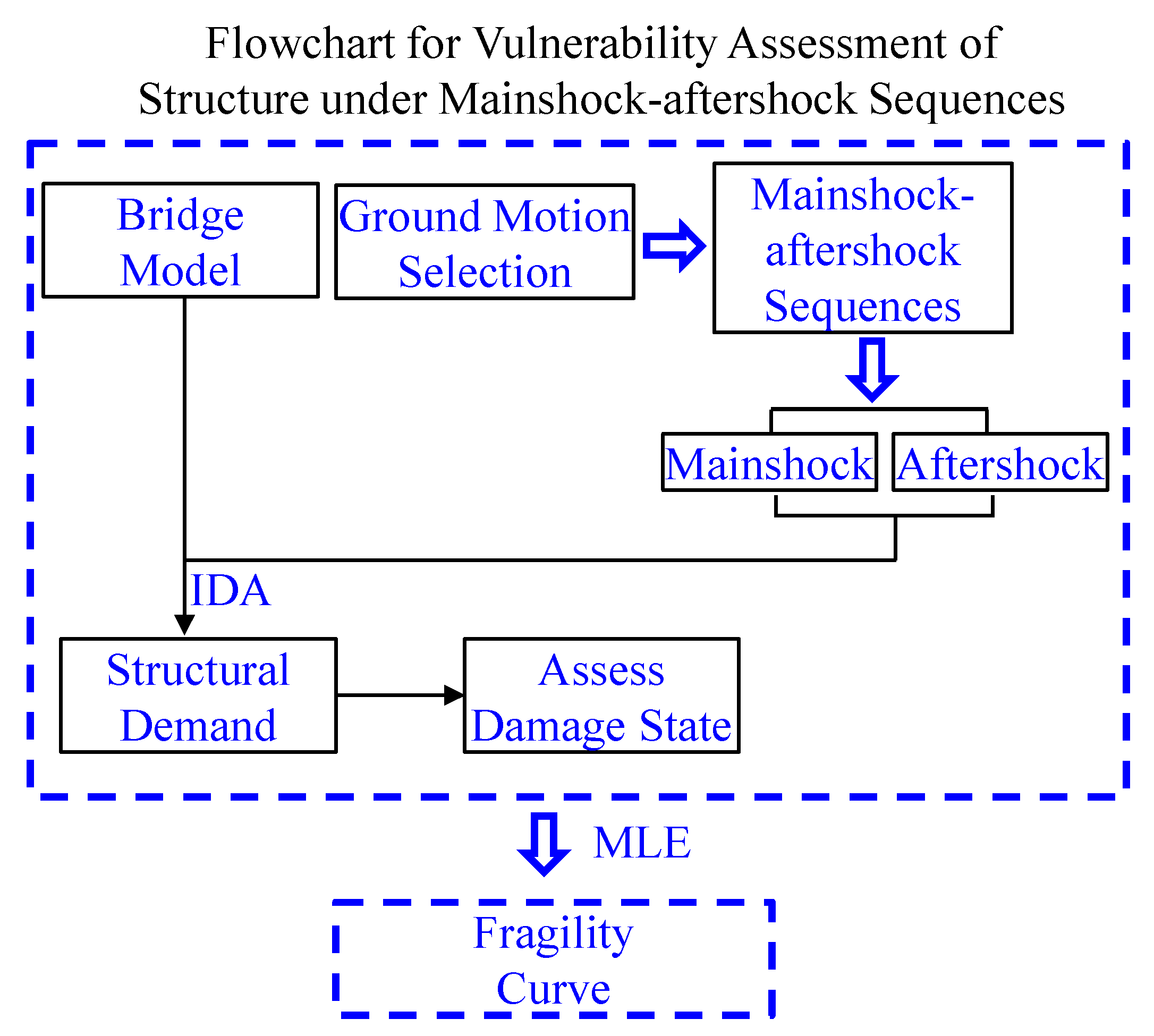
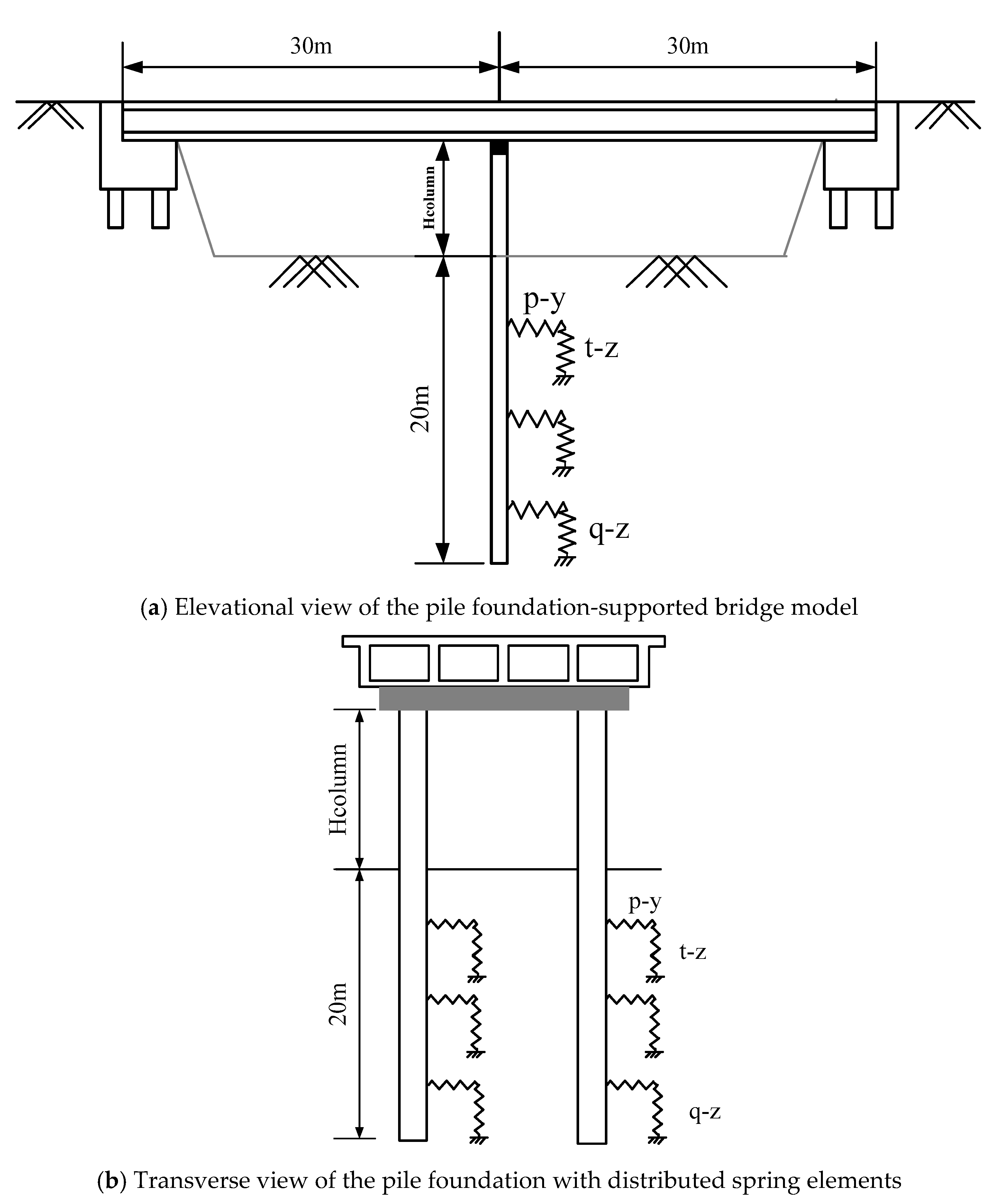


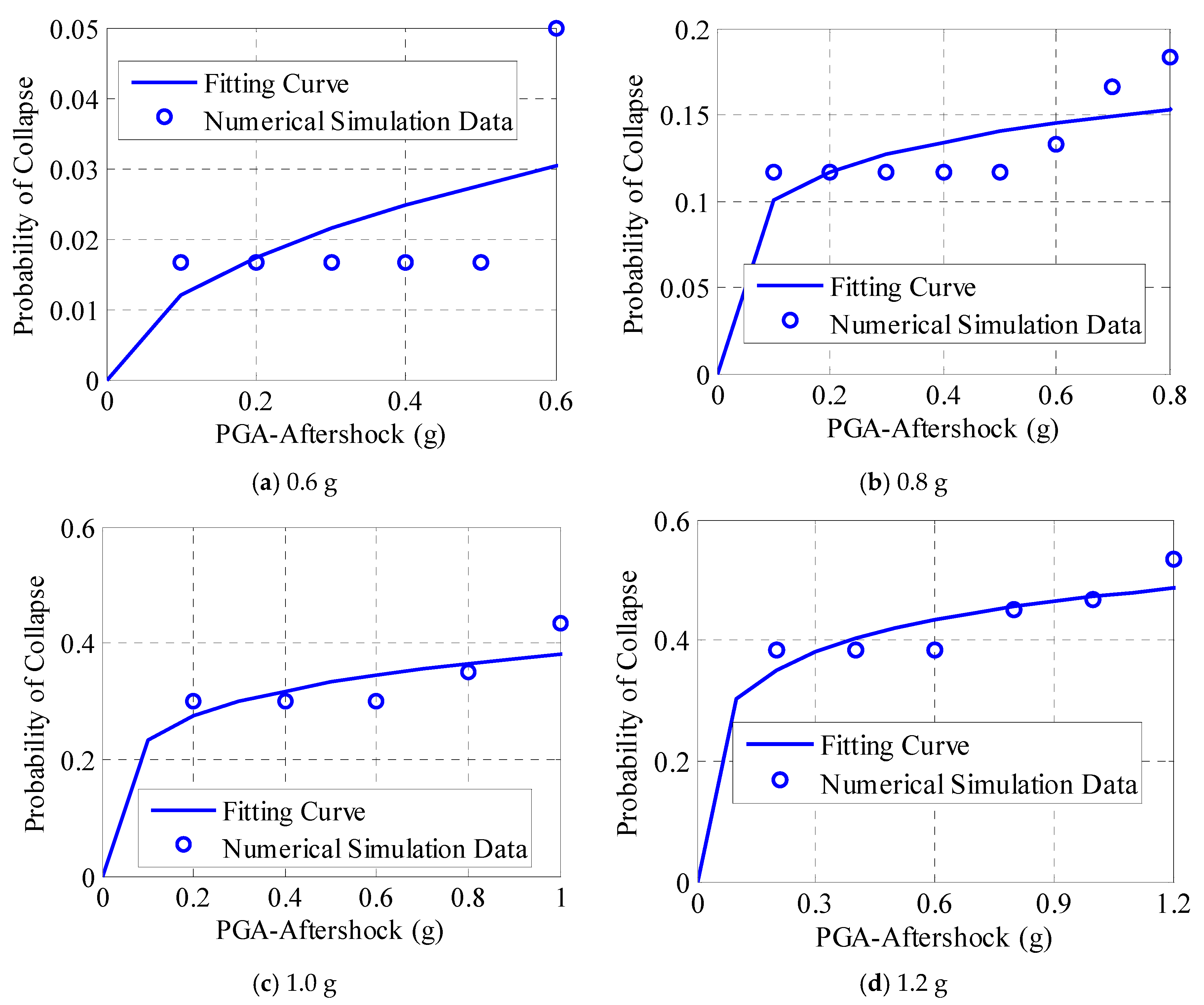
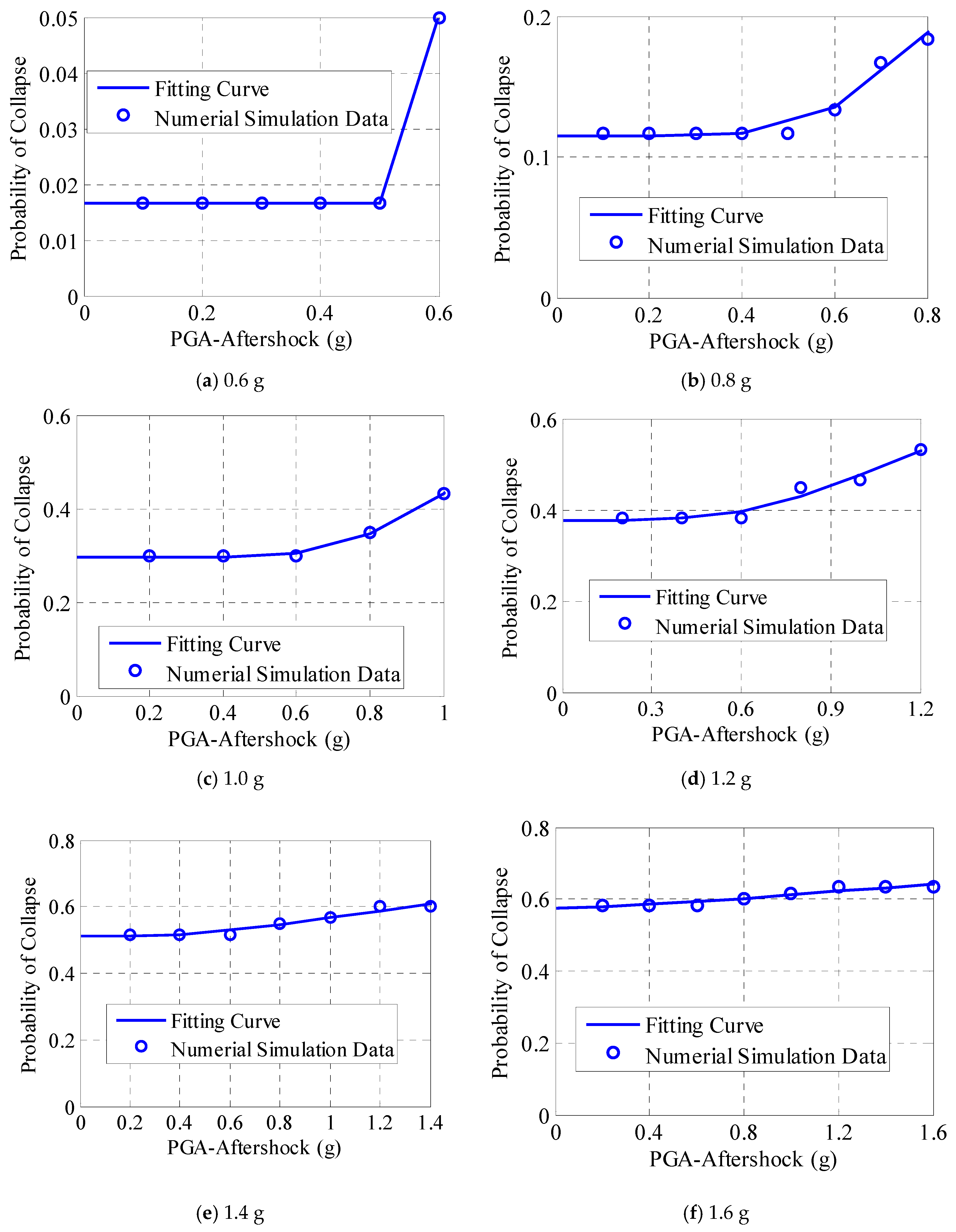
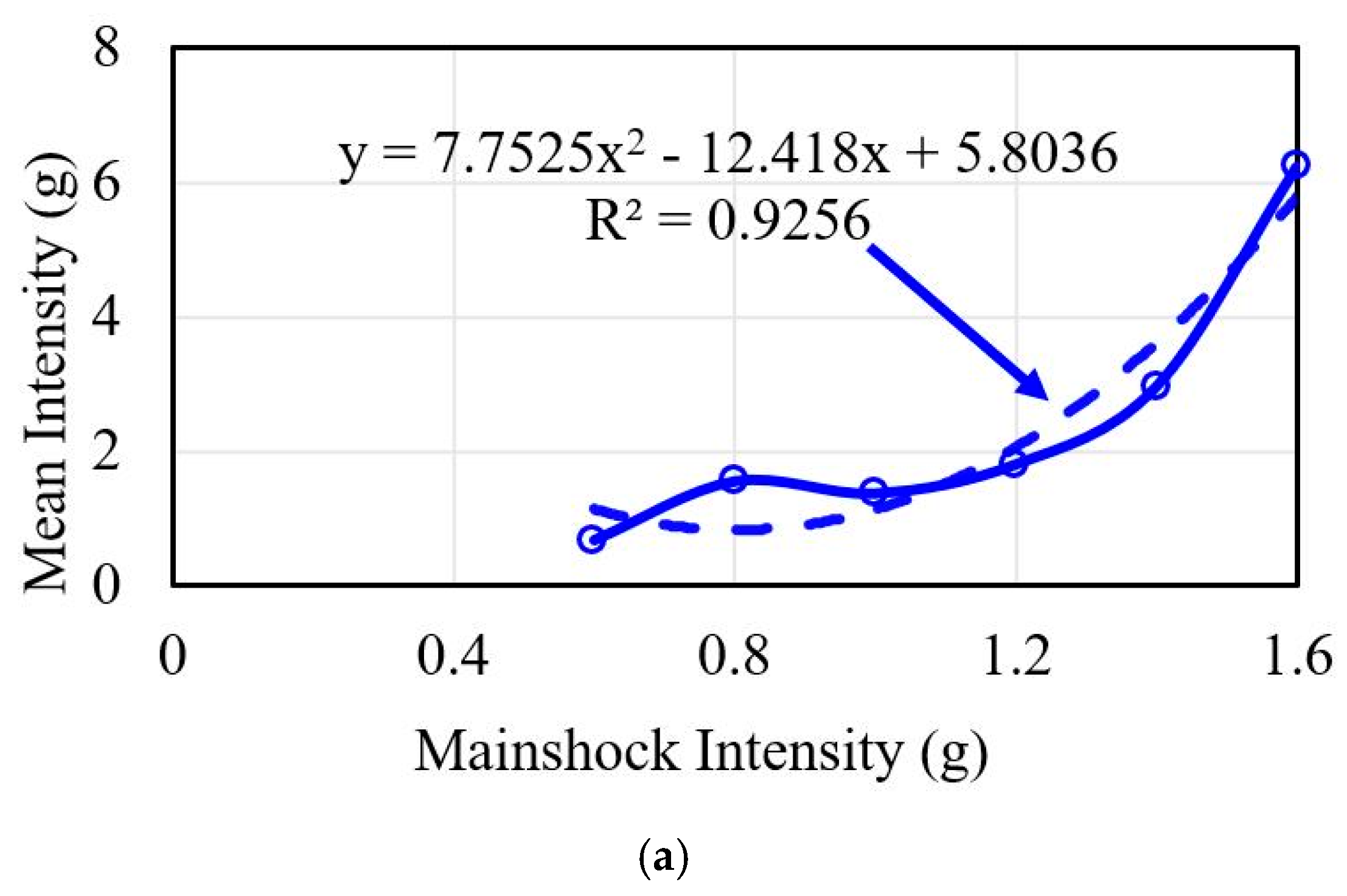
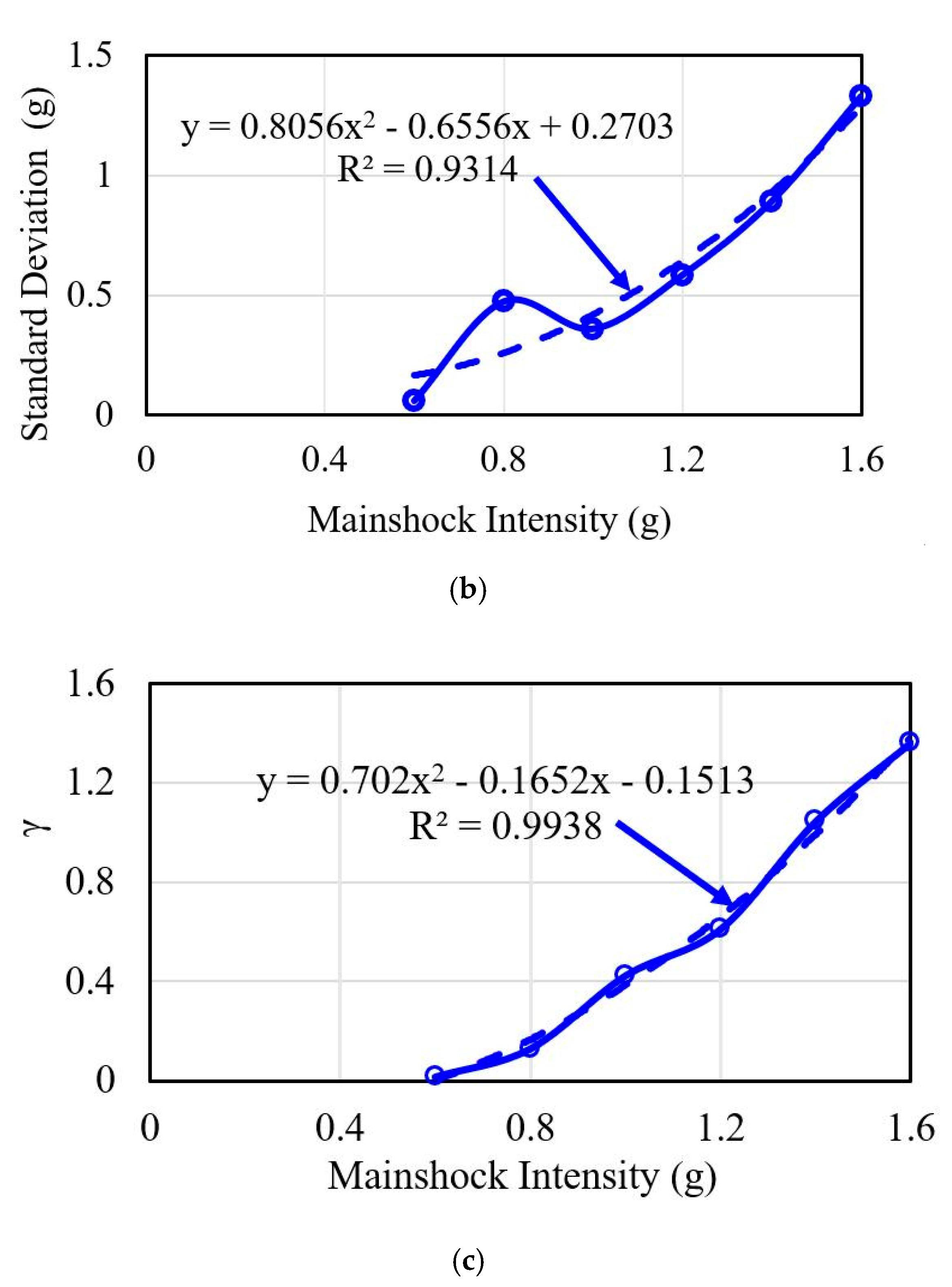
| Num. | Mainshock | Aftershock | Earthquake Event | ||||
|---|---|---|---|---|---|---|---|
| Sequence | M | Rrup (km) | Sequence | M | Rrup (km) | ||
| 1 | 1180 | 7.62 | 24.96 | 3863 | 6.3 | 50.27 | CHI-CHI |
| 2 | 1181 | 7.62 | 47.32 | 3851 | 6.2 | 61.84 | CHI-CHI |
| 3 | 1182 | 7.62 | 9.76 | 3865 | 6.3 | 40.64 | CHI-CHI |
| 4 | 1183 | 7.62 | 40.43 | 3866 | 6.3 | 70.74 | CHI-CHI |
| 5 | 1184 | 7.62 | 19.96 | 3867 | 6.3 | 48.43 | CHI-CHI |
| 6 | 1185 | 7.62 | 59.04 | 3868 | 6.3 | 89.11 | CHI-CHI |
| 7 | 1186 | 7.62 | 34.18 | 3258 | 6.3 | 59.98 | CHI-CHI |
| 8 | 1187 | 7.62 | 38.13 | 3259 | 6.3 | 66.88 | CHI-CHI |
| 9 | 1188 | 7.62 | 66.64 | 3260 | 6.3 | 96.03 | CHI-CHI |
| 10 | 1189 | 7.62 | 59.09 | 3261 | 6.3 | 87.57 | CHI-CHI |
| 11 | 1190 | 7.62 | 50.53 | 3262 | 6.3 | 76.56 | CHI-CHI |
| 12 | 1191 | 7.62 | 63.21 | 3263 | 6.3 | 89.44 | CHI-CHI |
| 13 | 1193 | 7.62 | 9.62 | 3264 | 6.3 | 31.14 | CHI-CHI |
| 14 | 1194 | 7.62 | 19.07 | 3265 | 6.3 | 40.33 | CHI-CHI |
| 15 | 1195 | 7.62 | 29.52 | 3266 | 6.3 | 50.64 | CHI-CHI |
| 16 | 1196 | 7.62 | 41.99 | 3267 | 6.3 | 66.82 | CHI-CHI |
| 17 | 1197 | 7.62 | 3.12 | 3268 | 6.3 | 33.61 | CHI-CHI |
| 18 | 1198 | 7.62 | 10.96 | 3269 | 6.3 | 41.36 | CHI-CHI |
| 19 | 1199 | 7.62 | 35.43 | 3271 | 6.3 | 65.02 | CHI-CHI |
| 20 | 1200 | 7.62 | 43.82 | 3272 | 6.3 | 73.61 | CHI-CHI |
| 21 | 1201 | 7.62 | 14.82 | 3273 | 6.3 | 44.67 | CHI-CHI |
| 22 | 1202 | 7.62 | 12.65 | 3274 | 6.3 | 41.58 | CHI-CHI |
| 23 | 1203 | 7.62 | 16.04 | 3275 | 6.3 | 46.19 | CHI-CHI |
| 24 | 1204 | 7.62 | 31.87 | 3277 | 6.3 | 62.26 | CHI-CHI |
| 25 | 1205 | 7.62 | 19.83 | 3278 | 6.3 | 46.76 | CHI-CHI |
| 26 | 1206 | 7.62 | 28.17 | 3279 | 6.3 | 54.36 | CHI-CHI |
| 27 | 1207 | 7.62 | 55.13 | 3280 | 6.3 | 85.35 | CHI-CHI |
| 28 | 1208 | 7.62 | 24.1 | 3281 | 6.3 | 54.11 | CHI-CHI |
| 29 | 1209 | 7.62 | 24.13 | 3282 | 6.3 | 54.47 | CHI-CHI |
| 30 | 1210 | 7.62 | 44.76 | 3283 | 6.3 | 72.33 | CHI-CHI |
| 31 | 1211 | 7.62 | 39.02 | 3284 | 6.3 | 65.54 | CHI-CHI |
| 32 | 1212 | 7.62 | 48.49 | 3285 | 6.3 | 77.63 | CHI-CHI |
| 33 | 1213 | 7.62 | 54.3 | 3286 | 6.3 | 83.36 | CHI-CHI |
| 34 | 1214 | 7.62 | 56.93 | 3287 | 6.3 | 83.26 | CHI-CHI |
| 35 | 1216 | 7.62 | 73.26 | 3289 | 6.3 | 102.63 | CHI-CHI |
| 36 | 1256 | 7.62 | 56.93 | 3324 | 6.3 | 51.83 | CHI-CHI |
| 37 | 1257 | 7.62 | 56.14 | 3325 | 6.3 | 56.02 | CHI-CHI |
| 38 | 1258 | 7.62 | 47.58 | 2997 | 6.2 | 33.61 | CHI-CHI |
| 39 | 1259 | 7.62 | 47.86 | 2761 | 6.2 | 57.84 | CHI-CHI |
| 40 | 1260 | 7.62 | 56.3 | 3326 | 6.3 | 57.24 | CHI-CHI |
| 41 | 130 | 5.91 | 11.03 | 4276 | 5.5 | 12.39 | Friuli-02 |
| 42 | 122 | 6.5 | 33.4 | 131 | 5.91 | 41.39 | Friuli-01 |
| 43 | 132 | 5.91 | 14.75 | 4277 | 5.5 | 16.52 | Friuli-02 |
| 44 | 133 | 5.91 | 14.37 | 4278 | 5.5 | 16.31 | Friuli-02 |
| 45 | 125 | 6.5 | 15.82 | 4267 | 5.2 | 25.09 | Friuli-01 |
| 46 | 949 | 6.69 | 8.66 | 1651 | 6.05 | 12.06 | Northridge-01 |
| 47 | 954 | 6.69 | 19.74 | 1695 | 5.28 | 25.83 | Northridge |
| 48 | 963 | 6.69 | 20.72 | 1652 | 6.05 | 29.54 | Northridge |
| 49 | 974 | 6.69 | 22.21 | 3779 | 5.28 | 24.74 | Northridge |
| 50 | 978 | 6.69 | 23.07 | 1701 | 5.28 | 19.62 | Northridge |
| 51 | 981 | 6.69 | 42.2 | 1655 | 6.05 | 39.16 | Northridge |
| 52 | 982 | 6.69 | 5.43 | 1703 | 5.28 | 14.69 | Northridge |
| 53 | 984 | 6.69 | 41.17 | 1656 | 6.05 | 38.69 | Northridge |
| 54 | 985 | 6.69 | 29.88 | 1657 | 6.05 | 27.19 | Northridge |
| 55 | 988 | 6.69 | 15.53 | 1658 | 6.05 | 20.47 | Northridge |
| 56 | 990 | 6.69 | 36.62 | 1659 | 6.05 | 33.8 | Northridge |
| 57 | 995 | 6.69 | 24.03 | 1660 | 6.05 | 20.68 | Northridge |
| 58 | 996 | 6.69 | 20.81 | 1711 | 5.28 | 17.14 | Northridge |
| 59 | 999 | 6.69 | 37.36 | 1661 | 6.05 | 34.36 | Northridge |
| 60 | 1004 | 6.69 | 8.44 | 3771 | 5.28 | 11.66 | Northridge |
© 2020 by the authors. Licensee MDPI, Basel, Switzerland. This article is an open access article distributed under the terms and conditions of the Creative Commons Attribution (CC BY) license (http://creativecommons.org/licenses/by/4.0/).
Share and Cite
Guo, X.; Zhang, Z.; Chen, Z. Mainshock-Integrated Aftershock Vulnerability Assessment of Bridge Structures. Appl. Sci. 2020, 10, 6843. https://doi.org/10.3390/app10196843
Guo X, Zhang Z, Chen Z. Mainshock-Integrated Aftershock Vulnerability Assessment of Bridge Structures. Applied Sciences. 2020; 10(19):6843. https://doi.org/10.3390/app10196843
Chicago/Turabian StyleGuo, Xuan, Zheyu Zhang, and ZhiQiang Chen. 2020. "Mainshock-Integrated Aftershock Vulnerability Assessment of Bridge Structures" Applied Sciences 10, no. 19: 6843. https://doi.org/10.3390/app10196843
APA StyleGuo, X., Zhang, Z., & Chen, Z. (2020). Mainshock-Integrated Aftershock Vulnerability Assessment of Bridge Structures. Applied Sciences, 10(19), 6843. https://doi.org/10.3390/app10196843





